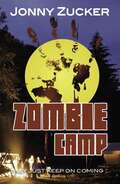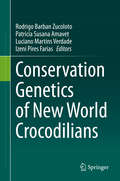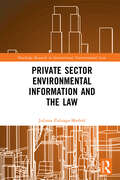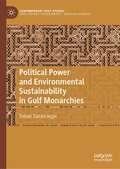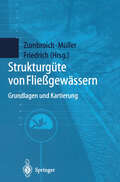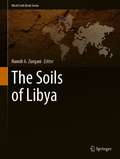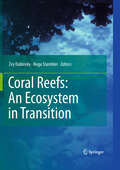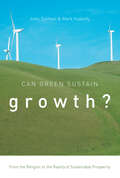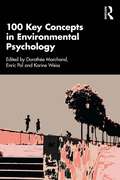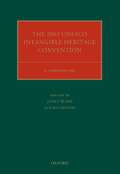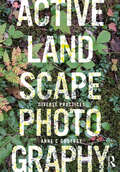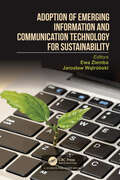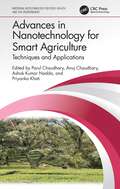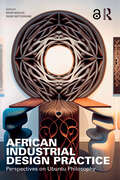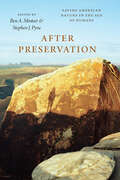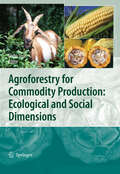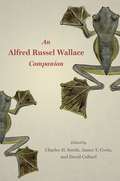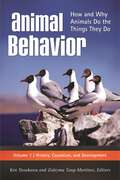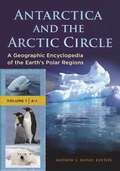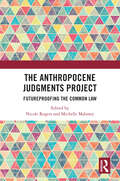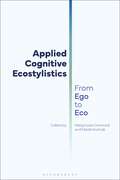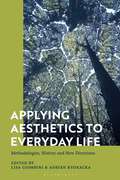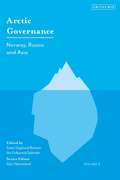- Table View
- List View
Zombie Camp (Toxic Ser.)
by Jonny ZuckerArjun and Kev are at summer camp. It's great - there's lots to do and plenty of places to explore. But after a while they begin to suspect that nothing is quite as it seems. The camp leaders seems to be acting very strangely. Could they possibly be . zombies? Can the two boys avoid the terrible fate that seems to await them? Action! Adventure! Danger! This standalone book from Jonny Zucker's Toxic series is a fast-moving chapter book, filled with high-quality black and white illustrations to grab readers' attention. The Toxic series reads are ideal for reluctant and struggling readers who are enthused by short, fast-paced adventure stories. The cliff-hanger at the end of nearly every chapter certainly helps!
Conservation Genetics of New World Crocodilians
by Rodrigo Barban Zucoloto Patricia Susana Amavet Luciano Martins Verdade Izeni Pires FariasThis book aims to be a comprehensive review of the literature on the conservation genetics of the New World crocodilians, from the biological and demographical aspects of the living species to the application of molecular techniques for conservation purposes. It covers the current status of the molecular genetics applied to phylogenetics, phylogeography, diversity, kinship and mating system, and hybridization, as well its implications for decision making with regards to the conservation of these species at academic and governmental levels. This book can be used as a guide for graduate and undergraduate students to understand how conservation genetics techniques are carried out and how they can help preserve not only crocodilians but also other living species.
Private Sector Environmental Information and the Law (Routledge Research in International Environmental Law)
by Juliana Zuluaga MadridCurrent advancements in civil rights and environmental activism emphasize the crucial importance of making environmental information widely available to the public, regardless of whether it is in the hands of the government or of corporations, especially when the information is needed to understand and prevent risks for human health and the environment. In the wake of a resurgence of environmental and civil rights activism, conflicts flare between the right of the people to know and the right of private actors to keep certain information hidden, mostly for commercial reasons. This book offers a detailed comparative analysis of how environmental information is being accessed in different countries and jurisdictions, and how these issues are currently being handled by judges and governments. Focusing on the right of access to environmental information held and produced by private actors and the legal issues that emerge when other values and rights are compromised, this book offers an alternative framework to improve on current legal systems, suggesting a more nuanced and balanced approach that takes both set of interests duly into consideration. Providing an integrated approach to public environmental law and private commercial law, the book integrates the arguments from both sides to establish a common ground, defining shared principles and models that provide a solid basis for a robust new system. Reviewing access to private sector information at a truly international level, this book will be relevant to students, academics and practitioners working in these areas.
Private Sector Environmental Information and the Law (Routledge Research in International Environmental Law)
by Juliana Zuluaga MadridCurrent advancements in civil rights and environmental activism emphasize the crucial importance of making environmental information widely available to the public, regardless of whether it is in the hands of the government or of corporations, especially when the information is needed to understand and prevent risks for human health and the environment. In the wake of a resurgence of environmental and civil rights activism, conflicts flare between the right of the people to know and the right of private actors to keep certain information hidden, mostly for commercial reasons. This book offers a detailed comparative analysis of how environmental information is being accessed in different countries and jurisdictions, and how these issues are currently being handled by judges and governments. Focusing on the right of access to environmental information held and produced by private actors and the legal issues that emerge when other values and rights are compromised, this book offers an alternative framework to improve on current legal systems, suggesting a more nuanced and balanced approach that takes both set of interests duly into consideration. Providing an integrated approach to public environmental law and private commercial law, the book integrates the arguments from both sides to establish a common ground, defining shared principles and models that provide a solid basis for a robust new system. Reviewing access to private sector information at a truly international level, this book will be relevant to students, academics and practitioners working in these areas.
Political Power and Environmental Sustainability in Gulf Monarchies (Contemporary Gulf Studies)
by Tobias ZumbraegelThis book offers a new perspective about the Gulf Arab states entering a post-oil era by looking at the political factors behind the green transformation. It discusses the recent ‘environmental enthusiasm’ in the oil- and gas-rich Gulf monarchies by asking how political power can be constituted through advocating environmental sustainability. While hydrocarbon-wealthy Gulf monarchies have been viewed as the globe’s ‘hydrocarbon powerhouse’ with an immense ecological footprint, efforts towards sustainability and environmental protection measures are increasingly monitored. Climate Change, environmental, degradation and the global pressure towards a low-carbon development are threatening the very basis of economic and political power of the oil- and gas-exporting Gulf monarchies. So far, discussions about this fundamental transformation have barely elaborated how it affects and reorganizes political power games in the region. This book attempts to overcome the dominant focus of techno economic drivers of change and uncovers how environmental sustainability impacts state-society and state-elite relationships as well as shaping regional and even global geopolitics.
Strukturgüte von Fließgewässern: Grundlagen und Kartierung
by Thomas Zumbroich Andreas Müller Günther FriedrichThe Soils of Libya (World Soils Book Series)
by Hamdi A. ZurqaniThis book presents the soil pedodiversity in Libya. Soils are the source of all life; there can be no life without them. Further, each soil has its own history and its present conditions, which have been shaped by many different factors (e.g. climate, biota, parent material, and relief or topography). The book, divided into eight chapters, provides extensive information on Libyan soils. Chapter one provides an introduction and a broad perspective of the subject, while Chapter two covers the history of soil mapping and research in Libya. Chapter three focuses on local factors of soil formation and describes the geology and climate of the region to explain the diversity of its soils. Chapter four discusses soil classification systems and those most commonly used in the country. The fifth chapter illustrates the constraints and limiting factors that negatively affect agricultural activities across the country. The land cover/land use and the vegetation of the country are described in Chapter six. In turn, Chapter seven presents the status quo of soil biology, the corresponding related research activities, and the other biological properties of Libyan soils. The final chapter (Chapter eight) focus on land degradation and desertification in Libya, emphasizing the main causes, impacts of the phenomena, and efforts to combat it. This book demonstrates the problems that the country is currently facing as a result of climate change, soil erosion, salinization, and pollution, and outlines potential remedies to improve local food security. Bringing together the perspectives and expertise of many distinguished scientists from various universities and institutions in and outside of Libya, the book represents a unique and highly valuable resource.
Coral Reefs: An Ecosystem in Transition
by Zvy Dubinsky and Noga StamblerThis book covers in one volume materials scattered in hundreds of research articles, in most cases focusing on specialized aspects of coral biology. In addition to the latest developments in coral evolution and physiology, it presents chapters devoted to novel frontiers in coral reef research. These include the molecular biology of corals and their symbiotic algae, remote sensing of reef systems, ecology of coral disease spread, effects of various scenarios of global climate change, ocean acidification effects of increasing CO2 levels on coral calcification, and damaged coral reef remediation. Beyond extensive coverage of the above aspects, key issues regarding the coral organism and the reef ecosystem such as calcification, reproduction, modeling, algae, reef invertebrates, competition and fish are re-evaluated in the light of new research and emerging insights. In all chapters novel theories as well as challenges to established paradigms are introduced, evaluated and discussed. This volume is indispensible for all those involved in coral reef management and conservation.
The End Of Man: A Feminist Counterapocalypse (PDF) (Forerunners: Ideas First)
by Joanna ZylinskaWhere the Anthropocene has become linked to an apocalyptic narrative, and where this narrative carries a widespread escapist belief that salvation will come from a supernatural elsewhere, Joanna Zylinska has a different take. The End of Man rethinks the prophecy of the end of humans, interrogating the rise in populism around the world and offering an ethical vision of a "feminist counterapocalypse," which challenges many of the masculinist and technicist solutions to our planetary crises. The book is accompanied by a short photo-film, Exit Man, which ultimately asks: If unbridled progress is no longer an option, what kinds of coexistences and collaborations do we create in its aftermath?
Can Green Sustain Growth?: From the Religion to the Reality of Sustainable Prosperity (Innovation and Technology in the World Economy)
by John Zysman Mark HubertyGreen growth has proven to be politically popular, but economically elusive. Can Green Sustain Growth? asks how we can move from theoretical support to implementation, and argues that this leap will require radical experimentation. But systemic change is costly, and a sweeping shift cannot be accomplished without political support, not to mention large-scale cooperation between business and government. Insightful and timely, this book brings together eight original, international case studies to consider what we can learn from the implementation of green growth strategies to date. This analysis reveals that coalitions for green experimentation emerge and survive when they link climate solutions to specific problems with near-term benefits that appeal to both environmental and industrial interests. Based on these findings, the volume delivers concrete policy recommendations for the next steps in the necessary shift toward sustainable prosperity.
100 Key Concepts in Environmental Psychology
This accessible book defines 100 key concepts, ideas and processes in Environmental Psychology to provide an introductory reference work that brings together research and theory in a bite-size format. With contributions from leading figures within Environmental Psychology, each concept is clearly defined and explained within the context of issues around the environment, sustainability, climate change, nature and architecture. This book considers the involvement of psychological, physiological and social processes to understand the mechanisms that explain and contribute to the evolution of behavior and attitudes that relate to our relationship with the environment. Concepts covered include biodiversity, eco-anxiety, place identity, sustainable behaviour, climate justice and environmental attitudes. By integrating ideas from different disciplinary orientations in the field of Environmental Psychology, this book allows for a better understanding of the processes related to the individual-environment relationship, as well as the applications that they allow for in various fields of intervention. This is essential reading for students and researchers in Environmental Psychology, Sustainability Studies, Architecture and Built Environment Studies and related fields.
The 2003 UNESCO Intangible Heritage Convention: A Commentary (Oxford Commentaries on International Cultural Heritage Law)
This book critically analyses the 2003 Convention for the Safeguarding of the Intangible Cultural Heritage, UNESCO's latest and ground-breaking treaty in the area of cultural heritage protection. Intangible cultural heritage is broadly understood as the social processes that inform our living cultures, and our social cohesion and identity as communities and peoples. On the basis of this conception, the Treaty proposes to turn our understanding of how, for whom, and why heritage is safeguarded on its head, by putting communities, groups and individuals at the centre of the safeguarding process. The commentary, written by leading experts in the field from all continents and multiple disciplines, provides an authoritative guide to interpreting and implementing not only this Treaty, but also its ripple effects on how we think about cultural heritage and our experience with it as a part of our living cultures. This book is of interest to lawyers, policy-makers, anthropologists, cultural diplomacy specialists, archaeologists, cultural heritage studies experts, and, foremost, the people who practice and enact this heritage.
Active Landscape Photography: Diverse Practices (Active Landscape Photography)
Diverse Practices, the third book in the Active Landscape Photography series, presents a set of unique photographic examples for site-specific investigations of landscape places. Contributed by authors across academia, practice and photography, each chapter serves as a rigorous discussion about photographic methods for the landscape and their underlying concepts. Chapters also serve as unique case studies about specific projects, places and landscape issues. Project sites include the Miller Garden, Olana, XX Miller Prize and the Philando Castile Peace Garden. Landscape places discussed include the archeological landscapes of North Peru, watery littoral zones, the remote White Pass in Alaska, Sau Paulo and New York City’s Chinatown. Photographic image-making approaches include the use of lidar, repeat photography, collage, mapping, remote image capture, portraiture, image mining of internet sources, visual impact assessment, cameraless photography, transect walking and interviewing. These diverse practices demonstrate how photography, when utilized through a set of specific critical methods, becomes a rich process for investigating the landscape. Exploring this concept in relationship to specific contemporary sties and landscape issues reveals the intricacy and subtlety that exists when photography is used actively. Practitioners, academics, students and researchers will be inspired by the underlying concepts of these examples and come away with a better understanding about how to create their own rigorous photographic practices.
Adoption of Emerging Information and Communication Technology for Sustainability
This book represents an important voice in the discourse on the adoption of emerging ICT for sustainability. It focuses on how emerging ICT acts as a crucial enabler of sustainability, offering new forward-looking approaches to this field. The book explores how emerging ICT adoption drives sustainability efforts in business and public organizations, promoting ecological, economic, social, cultural, and political sustainability. The book's theoretical discussions, conceptual approaches, empirical studies, diverse perspectives, and views make it a valuable and comprehensive reference work. Appealing to both researchers and practitioners, this book provides significant areas for research and practice related to the contribution of emerging ICT adoption to sustainability. It also suggests vital considerations for programming and building sustainable development-driven emerging ICT adoption. Readers will find answers to important contemporary questions, such as: What are the concepts, frameworks, models, and approaches to enhance sustainable development through the adoption of emerging ICT? How does the adoption of emerging ICT influence sustainability? How can emerging ICT be adopted to enhance sustainability? What are the current practices and successful cases of emerging ICT adoption for sustainability? What factors influence emerging ICT adoption to enhance sustainability?
Advances in Nanotechnology for Smart Agriculture: Techniques and Applications (Microbial Biotechnology for Food, Health, and the Environment)
The yield of major agricultural crops can be severely decreased due to the inappropriate application of commonly used harmful chemicals. Excessive agrochemicals in field application can negatively affect microbial populations and their diversity, which in turn ultimately affects plant growth. Thus, it is necessary to turn toward more eco-friendly approaches which equally protect crops as well as the desirable microbial populations of complex soil systems. Nanoparticles are considered as potential agents for the production and development of sustainable agriculture. Green synthesis of nanoparticles has gained attention as a useful measure to diminish the harmful effects associated with the old methods of nanoparticle synthesis. Advances in Nanotechnology for Smart Agriculture: Techniques and Applications illustrates the science and practical applications of nanoparticles for sustainable agriculture. Features: Examines the role of nanotechnology in agricultural best practices, including sustainable development, precision farming, and long-term soil health
African Industrial Design Practice: Perspectives on Ubuntu Philosophy
The underlying principle of this book is the African philosophy of Ubuntu, which acts as a guide for developing empathic products and services. The book makes the case that empathy is the key to any successful product and service design project because it enables designers to make wise design choices that align with users' demands.Fifteen chapters provide the latest industrial design developments, techniques, and processes explicitly targeting emerging economies. At the outset, it covers the design context and the philosophy of the Ubuntu approach, which places people and communities at the centre of the development agenda. The book covers new product development, design research, design cognition, digital and traditional prototyping, bringing products to the market, establishing a company's brand name, intellectual property rights, traditional knowledge, and the business case for design in Afrika. It concludes with a discussion about the future of design and the skills aspiring designers will need.African Industrial Design Practice: Perspectives on Ubuntu Philosophy will be an essential textbook for undergraduates, postgraduates, instructors, and beginner designers in emerging economies to provide regionally contextualised design processes, illustrated examples, and outcomes.Chapter 2 of this book is freely available as a downloadable Open Access PDF at http://www.taylorfrancis.com under a Creative Commons Attribution-Non Commercial-No Derivatives (CC-BY-NC-ND) 4.0 license.
After Preservation: Saving American Nature in the Age of Humans
From John Muir to David Brower, from the creation of Yellowstone National Park to the Endangered Species Act, environmentalism in America has always had close to its core a preservationist ideal. Generations have been inspired by its ethos—to encircle nature with our protection, to keep it apart, pristine, walled against the march of human development. But we have to face the facts. Accelerating climate change, rapid urbanization, agricultural and industrial devastation, metastasizing fire regimes, and other quickening anthropogenic forces all attest to the same truth: the earth is now spinning through the age of humans. After Preservation takes stock of the ways we have tried to both preserve and exploit nature to ask a direct but profound question: what is the role of preservationism in an era of seemingly unstoppable human development, in what some have called the Anthropocene? Ben A. Minteer and Stephen J. Pyne bring together a stunning consortium of voices comprised of renowned scientists, historians, philosophers, environmental writers, activists, policy makers, and land managers to negotiate the incredible challenges that environmentalism faces. Some call for a new, post-preservationist model, one that is far more pragmatic, interventionist, and human-centered. Others push forcefully back, arguing for a more chastened and restrained vision of human action on the earth. Some try to establish a middle ground, while others ruminate more deeply on the meaning and value of wilderness. Some write on species lost, others on species saved, and yet others discuss the enduring practical challenges of managing our land, water, and air. From spirited optimism to careful prudence to critical skepticism, the resulting range of approaches offers an inspiring contribution to the landscape of modern environmentalism, one driven by serious, sustained engagements with the critical problems we must solve if we—and the wild garden we may now keep—are going to survive the era we have ushered in. Contributors include: Chelsea K. Batavia, F. Stuart (Terry) Chapin III, Norman L. Christensen, Jamie Rappaport Clark, William Wallace Covington, Erle C. Ellis, Mark Fiege, Dave Foreman, Harry W. Greene, Emma Marris, Michelle Marvier, Bill McKibben, J. R. McNeill, Curt Meine, Ben A. Minteer, Michael Paul Nelson, Bryan Norton, Stephen J. Pyne, Andrew C. Revkin, Holmes Rolston III, Amy Seidl, Jack Ward Thomas, Diane J. Vosick, John A. Vucetich, Hazel Wong, and Donald Worster.
Agroforestry for Commodity Production: Ecological and Social Dimensions
Agroforestry systems have been touted as sustainable production systems that alleviate many of the environmental problems associated with modern production systems. Are they indeed ecologically and economically sustainable? Using case studies from around the globe, this book highlights the potential of agroforestry systems to produce a broad range of commodities. In addition to addressing the biophysical and socioeconomic dimensions of producing traditional food, fodder and fiber crops, this volume examines the potential to integrate biomass crops, botanicals and ornamental plants into agroforestry practices. The book should be particularly useful to students, professionals, researchers and policy makers involved in natural resource management, agroforestry, and environmental management.
An Alfred Russel Wallace Companion
Although Alfred Russel Wallace (1823–1913) was one of the most famous scientists in the world at the time of his death at the age of ninety, today he is known to many as a kind of “almost-Darwin,” a secondary figure relegated to the footnotes of Darwin’s prodigious insights. But this diminution could hardly be less justified. Research into the life of this brilliant naturalist and social critic continues to produce new insights into his significance to history and his role in helping to shape modern thought. Wallace declared his eight years of exploration in southeast Asia to be “the central and controlling incident” of his life. As 2019 marks one hundred and fifty years since the publication of The Malay Archipelago, Wallace’s canonical work chronicling his epic voyage, this collaborative book gathers an interdisciplinary array of writers to celebrate Wallace’s remarkable life and diverse scholarly accomplishments. Wallace left school at the age of fourteen and was largely self-taught, a voracious curiosity and appetite for learning sustaining him throughout his long life. After years as a surveyor and builder, in 1848 he left Britain to become a professional natural history collector in the Amazon, where he spent four years. Then, in 1854, he departed for the Malay Archipelago. It was on this voyage that he constructed a theory of natural selection similar to the one Charles Darwin was developing, and the two copublished papers on the subject in 1858, some sixteen months before the release of Darwin’s On the Origin of Species. But as the contributors to the Companion show, this much-discussed parallel evolution in thought was only one epoch in an extraordinary intellectual life. When Wallace returned to Britain in 1862, he commenced a career of writing on a huge range of subjects extending from evolutionary studies and biogeography to spiritualism and socialism. An Alfred Russel Wallace Companion provides something of a necessary reexamination of the full breadth of Wallace’s thought—an attempt to describe not only the history and present state of our understanding of his work, but also its implications for the future.
Animal Behavior [3 volumes]: How and Why Animals Do the Things They Do [3 volumes]
Discover why animals do what they do, based on their genes, physiologies, cultures, traditions, survival and mating advantages, and evolutionary histories—and find out how studying behavior in the animal world helps us understand human behavior.The three volumes of Animal Behavior: How and Why Animals Do the Things They Do cover the breadth of the field, addressing causation, development, function, and evolution in a wide range of animals, from invertebrates to humans. Inspired by Nobel laureate Nikolaas Tinbergen's work, the first two volumes follow Tinbergen's four classic questions of animal behavior, while the third volume supplies integrated examples of Tinbergen's investigative process applied in specific cases.Written in an engaging, accessible manner ideal for college students as well as general audiences, this evidence-based collection provides a fascinating tour of animal behaviorists' findings, such as how animal communication can be truthful or deceitful, the deadly serious business behind clashes in the "battle of the sexes," and how documentation of animal behavior can lead to a deeper understanding of human behavior. Each chapter provides both historical background and information about current developments in animal behavior knowledge.
Antarctica and the Arctic Circle [2 volumes]: A Geographic Encyclopedia of the Earth's Polar Regions [2 volumes]
This one-stop reference is a perfect resource for anyone interested in the North and South Poles, whether their interest relates to history, wildlife, or the geography of these regions in the news today.Global warming, a hot topic among scholars of geography and science, has led to increased interest in studying the earth's polar ice caps, which seem to be melting at an alarming rate. This accessible, two-volume encyclopedia lays a foundation for understanding global warming and other issues related to the North and South Poles. Approximately 350 alphabetically arranged, user-friendly entries treat key terms and topics, important expeditions, major figures, territorial disputes, and much more.Readers will find information on the explorations of Cook, Scott, Amundsen, and Peary; articles on humpback whales, penguins, and polar bears; and explanations of natural phenomena like the Aurora Australis and the polar night. Expedition tourism is covered, as is climate change. Ideal for high school and undergraduate students studying geography, social studies, history, and earth science, the encyclopedia will provide a better understanding of these remote and unfamiliar lands and their place in today's world.
The Anthropocene Judgments Project: Futureproofing the Common Law
This book is a collection of speculative judgments that, along with accompanying commentaries, pursue a novel enquiry into how judges might respond to the formidable and planetary-scaled challenges of the Anthropocene. The book’s contributors –from Australia, Asia, Europe, and the United Kingdom –take up a range of issues: including multispecies justice, the challenges of intergenerational justice, dimensions of postcolonial justice, the potential contribution of AI platforms to the judgment process, and the future of judging and law in and beyond the Anthropocene. The project takes its inspiration from existing critical judgment projects. It is, however, thoroughly interdisciplinary. In anticipating future scenarios, and designing or adapting legal principles to respond to them, the book’s contributors have been assisted by climate scientists with expertise in future modelling; they have benefitted from the experience of fiction writers in future worldbuilding; and they have incorporated elements of the future worlds depicted in various texts of speculative fiction and artworks. The judgments are, of necessity, speculative and hypothetical in their subject matter. Thus, taken together, they constitute a collaborative experiment in creating the inclusive and radical imaginaries of the future common law. The Anthropocene Judgments Project will appeal to critical and sociolegal academics, scholars in the environmental humanities, environmental lawyers, students, and others with interests in the pressing issues of ecology, multispecies justice, climate change, the intersection of AI platforms and the law, and the future of law in the Anthropocene.
Applied Cognitive Ecostylistics: From Ego to Eco
This book offers an up-to-date account of one of the most influential strands of eco-research: cognitive ecostylistics. The onset of the 1970s saw a global shift in scholarly perspective upon the relation between egocentric and ecocentric views of the world. The so-called eco-turn was not only linguistic at its roots, but engaged the bulk of academic thought in social sciences and humanities. Cognitive ecostylistics invites a multidisciplinary approach to the study of the conceptual relations between oral or written texts and their impact on the environment. This volume is a collection of the latest research that seeks to apply the theory and methodology developed over the last 40 years to both literary and real-life texts, engaging with a wealth of examples from First World War poetry and Anne of Green Gables through to Condé Nast Traveller hotel descriptions. Exploring the cultural effects of the eco-turn, the collection engages the reader in the problem of the present-day Anthropocene, manifested as Ego-Eco tensions at the level of communicating self-needs and the needs of the Other. Divided into two parts, it considers first the human-angled semiotic interplay contained within the universe of people, before examining the problem of semiotic engagement of texts as extraneous to the human, highlighting crucial aspects of nature, culture, and beyond.
Applying Aesthetics to Everyday Life: Methodologies, History and New Directions
Applying Aesthetics to Everyday Life surveys current debates in the field of everyday aesthetics, examining its history, methodology and intersections with cognate research areas. Lisa Giombini and Adrián Kvokacka bring together an international team of renowned scholars who are shaping the present and future of the discipline. They demonstrate how the historical origins of everyday aesthetics emerges across the history of Western aesthetic thought, from Renaissance thinkers to the modern German philosophers Baumgarten, Kant and Heidegger. Chapters shed light on the field's methodological underpinnings, tracing its theoretical foundations back to epistemology and ethics and assess the potential of everyday aesthetics as a theoretical tool. They reveal its interdisciplinary nature and how it assists various fields of inquiry, including environmental and urban aesthetics, conservation ethics and the philosophy of art. Through fresh explorations of its origins, background and contemporary developments, this collection advances a new definition of everyday aesthetics and provides a cutting edge reflection on the world we inhabit today.
Arctic Governance: Norway, Russia and Asia (Arctic Governance)
The Polar North is known to be home to large gas and oil reserves and its position holds significant trading and military advantages, yet the maritime boundaries of the region remain ill-defined. In the twenty-first century the Arctic is undergoing profound change. As the sea ice melts, a result of accelerating climate change, global governance has become vital. In this, the third of three volumes, the latest research and analysis from the world's leading Arctic research body - the Fridtjof Nansen Institute - is brought together for the first time. Arctic Governance: Norway, Russia and Asia investigates the foreign policy discourses of Arctic governance, specifically as regarding international relations and competing interests between Norway, Russia and various Asian states.
